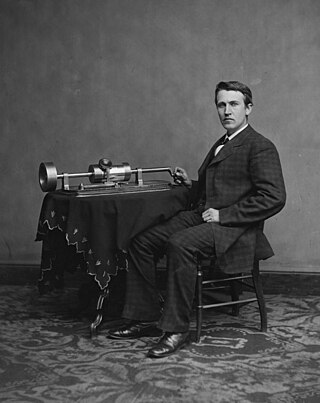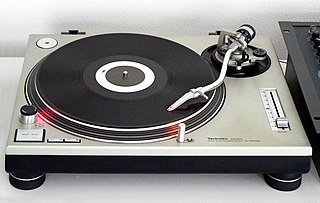This article needs additional citations for verification .(July 2007) |
The Technics SL-10 is a direct-drive, linear tracking automatic turntable, which was produced from 1979 to 1985.
Contents

This article needs additional citations for verification .(July 2007) |
The Technics SL-10 is a direct-drive, linear tracking automatic turntable, which was produced from 1979 to 1985.

The SL-10 was the first linear-tracking turntable to feature direct drive, a Technics innovation dating back to 1969 with the SP-10 Mk I. The SL-10, along with its fully programmable stablemate the SL-15, was able to penetrate the consumer electronics market much more effectively than any preceding linear-tracking turntable, and it spawned a wave of imitators throughout the 1980s, along with many derivations by Technics itself.
Unlike many of the inexpensive designs that followed it, the SL-10 is cast from aluminum and weighs 6.5 kg (14 lb). Its chassis is the same size as a standard LP jacket, doing away with the large plinth, visible tonearm and general bulk associated with conventional radial-tracking turntables that the public was familiar with up to that point.
The SL-10 came equipped with the Technics EPS-310MC moving-coil cartridge. Due to the low output of the moving-coil cartridge, the SL-10 includes a built-in, bypassable step-up preamp to allow it to connect to standard phono inputs. The original Technics EPS-310MC moving-coil cartridge was designed to be replaced as a unit; the stylus was not removable. The cartridge has since been discontinued; the SL-10 will accept any P-mount/T4P cartridge. The SL-10 is capable of being powered by an external DC power adapter or a standard AC power supply. The motor is quartz-locked, providing accurate rotational speed.
Perhaps the SL-10's most unusual feature is its ability to play records in any position, even in a vertical position, in fact records could be played upside down with the lid closed, the SL-10's internal disc clamp holds the record in place, and the tonearm, being dynamically balanced, maintains a consistent tracking force regardless of the turntable position.
An example of the SL-10 was in the collection of the Museum of Modern Art. [1]
Platter Type: 300mm (11¾") diameter die-cast aluminium [2]
Speed Accuracy: +/- 0.002%
Wow and Flutter: 0.025%
Rumble: -78 dB
Tonearm Type: Dynamic balanced linear tracking gimbal suspension
Effective Tonearm Length: 105mm (4¼")
Original Cartridge: EPC-310MC
Cartridge Frequency Response: 10 to 60,000 Hz
Dimensions: 315 x 88 x 315mm (12½" x 3½" x 12½")
Weight: 6.5kg (14 lb)

A phonograph, in its later forms also called a gramophone or since the 1940s called a record player, or more recently a turntable, is a device for the mechanical and analogue recording and reproduction of sound. The sound vibration waveforms are recorded as corresponding physical deviations of a spiral groove engraved, etched, incised, or impressed into the surface of a rotating cylinder or disc, called a "record". To recreate the sound, the surface is similarly rotated while a playback stylus traces the groove and is therefore vibrated by it, very faintly reproducing the recorded sound. In early acoustic phonographs, the stylus vibrated a diaphragm which produced sound waves which were coupled to the open air through a flaring horn, or directly to the listener's ears through stethoscope-type earphones.

Scratching, sometimes referred to as scrubbing, is a DJ and turntablist technique of moving a vinyl record back and forth on a turntable to produce percussive or rhythmic sounds. A crossfader on a DJ mixer may be used to fade between two records simultaneously.

A variable speed pitch control is a control on an audio device such as a turntable, tape recorder, or CD player that allows the operator to deviate from a standard speed, resulting in adjustments in pitch. The latter term "vari-speed" is more commonly used for tape decks, particularly in the UK. Analog pitch controls vary the voltage being used by the playback device; digital controls use digital signal processing to change the playback speed or pitch. A typical DJ deck allows the pitch to be increased or reduced by up to 8%, which is achieved by increasing or reducing the speed at which the platter rotates.

A magnetic cartridge, more commonly called a phonograph cartridge or phono cartridge or (colloquially) a pickup, is an electromechanical transducer that is used to play records on a turntable.

Technics SL-1200 is a series of direct-drive turntables originally manufactured from October 1972 until 2010, and resumed in 2016, by Matsushita Electric under the brand name of Technics. S means "Stereo", L means "Player". Originally released as a high fidelity consumer record player, it quickly became adopted among radio and disco club disc jockeys, thanks to the direct drive, high torque motor design, making it initially suitable for pushbutton cueing and starting of tracks on radio and in dance clubs. It is still extremely popular with audiophiles.
A record changer or autochanger is a device that plays several phonograph records in sequence without user intervention. Record changers first appeared in the late 1920s, and were common until the 1980s.
Roksan is a British manufacturer of high fidelity audio products for domestic use, based in Rayleigh, Essex. It is best known for its influential and innovative design for hi-fi equipment, and in particular its Xerxes platform for playing LP records.

The Linn Sondek LP12 is a transcription turntable produced by Glasgow-based Linn Products, manufacturers of hi-fi, home theatre, and multi-room audio systems. Its name is derived from the 12" vinyl LP.
Magnetic-tape data storage is a system for storing digital information on magnetic tape using digital recording.
Elektromesstechnik (EMT) is a manufacturer of phonograph turntables and professional audio equipment, including a well-regarded line of artificial reverberation devices beginning with the EMT 140 plate reverb. The company was founded by Wilhelm Franz.
Technics is a Japanese brand name of Panasonic for audio equipment. Since 1965, Panasonic has produced a variety of hi-fi and audio products under the brand name, such as turntables, amplifiers, radio receivers, tape recorders, CD players, speakers, and digital pianos. Technics products were available for sale in various countries. The brand was originally conceived as a line of high-end audio equipment to compete against brands such as Nakamichi.
Denon DL103 is an MC phono cartridge made by DENON company.

The Numark Pro TT-2, Pro TT-1+, Pro TT-1 and TT-100 were a family of private label, high end, direct drive DJ phonograph turntables sold by Numark during the late 1990s and early 2000s. Only in production for a few years, these models were among the early versions of the "Super OEM" manual DJ turntables made by the Hanpin Electron Co., Ltd. of Taiwan. The Pro TT-1, Pro TT-1+, and Pro TT-2 models incorporated a LCD display on the top plate to show turntable settings which included a unique 12 segment animated element to indicate platter rotation and direction.

Turntable anti-skating is a feature used in phonograph turntables to prevent skating of the tonearm.

SME is a brand name of an English company that produces high end tonearms and turntables, whose name has become synonymous with the industry standard detachable headshell mount.

The Roksan Xerxes transcription turntable is a record player named after the Persian king Xerxes I and produced by London-based Roksan Audio. Designed by Roksan co-founder, Touraj Moghaddam, the Xerxes is a belt-driven turntable with a solid plinth. Launched in 1985, the sound quality of the product positioned it as a strong competitor against the established industry leader, the Linn Sondek LP12. Many reviewers use the Xerxes as a reference turntable.

The Rega Planar 3, together with its successors, the P3 and RP3, is a well-known budget audiophile turntable by British hi-fi manufacturer, Rega Research available since 1977. It was a belt-drive deck that broke from convention, by employing a solid plinth in lieu of the compliantly suspended chassis or sub-chassis used in many quality turntables since the early 1960s.
The Technics SL-J2 is a quartz-controlled direct-drive fully automatic turntable system produced by Technics between 1984 and 1988. It features a linear tracking tonearm with an optical sensor that allows for the kind of track-skipping more typical of CD players. The sensor also detects the size of the record sitting on the platter, which allows the needle to drop precisely on the first track.

The Audio-Technica AT-LP120 is a mid-range direct-drive turntable introduced in 2009 by the Japanese audio equipment manufacturer Audio-Technica. The AT-LP120 was intended to be a viable replacement for the long-running Technics SL-1200 series of turntables that was set to be discontinued in 2010. It supports both phono and line-level output, using a built-in preamplifier.
U-Turn Audio is an American audio equipment manufacturer located in Woburn, Massachusetts. The company was established in 2012 by Benjamin Carter, Robert Hertig, and Peter Maltzan. Its primary products are turntables, phono preamps, and loudspeakers.